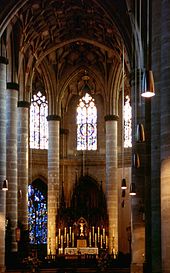Special German Gothic
The German Gothic Gothic is a term used in architectural style . However, due to its strong ideological coloring, it is now controversial. It was introduced in 1913 by Kurt Gerstenberg 's book of the same name and describes a special form of Gothic architecture that developed in the 14th and 15th centuries in the Holy Roman Empire of the German nation . The term was intended to emphasize the national independence of German development compared to French cathedral Gothic.
Classification and examples
From the middle of the 14th century on - roughly at the same time as the German special Gothic - corresponding independent styles also developed in other countries: the Flamboyant in France, the Perpendicular Style in England, the Isabelline Gothic in Spain, and the Emanuel Style in Portugal . What these architectural styles have in common is the abandonment of the classical Gothic of the Île-de-France with a clear unification of the spatial impression, as is characteristic of the secular buildings of the Renaissance. Nonetheless, “Gothic” style elements - in particular pointed arches and vault shapes - are not only retained, but developed further.
One of the earliest representatives is the Heilig-Kreuz-Münster zu Schwäbisch Gmünd , where the Parler family of architects constructed many elements of the German Gothic for the first time. Hall churches such as St. Michael in Schwäbisch Hall , St. Vitus Cathedral in Prague , the Frauenkirche in Nuremberg , the Leonhardskirche in Frankfurt am Main , the St. Anne's Church in Annaberg-Buchholz , the St. Wolfgang Church in Schneeberg , the St. George Church in Dinkelsbühl , St. Georg in Nördlingen or St. Martin in Lauingen , or hall choruses like the Lorenz Church in Nuremberg or the Franciscan Church in Salzburg .
Characteristic
The German special Gothic is characterized by elements that are quite unusual in France , the country of origin of the Gothic. It differs from the French models and their system in both reductions and enrichments.
In the architecture of the mendicant orders , but also outside of them, elements of the complete cathedral construction are dispensed with in various European countries in the introduction and further development of the Gothic style that originated in France. This style trend, referred to by German art historians ( Georg Dehio ) as " Reduction Gothic", spread around 1300 and created certain prerequisites for German special Gothic. The reductions include the elimination of the ambulatory , chapel wreath and triforium , and the eyelashes are also dispensed with (after the construction of the Strasbourg Cathedral and Cologne Cathedral ) . Capitals are completely absent. The use of simple round or octagonal supports instead of complicated bundle pillars calms the appearance.
The adaptation of the height of the side aisles to the main nave , that is, the development of the hall church with its wide, balanced interior creates a new type of space that appears as an alternative to the basilica cathedral building.
The twin towers of the episcopal churches, which are common in France, are opposed to the single towers of the parish churches . The building of the tower, which has been raised ever higher, is a special feature of German development. Enrichments occur mainly in the late Gothic. They particularly concern the increasingly complex shapes of the vaults , services and ribs. Typical are star, net and loop vaults as well as spiral pillars. Interiors such as the sacrament house in the Lorenz Church in Nuremberg by Adam Kraft (1496) also allow German stonemasonry to “culminate” in a flamboyant sense.
Classification
The buildings classified in the German special Gothic can be divided into three groups:
- Hall churches
- Churches of the order of mendicants (according to the basilic scheme)
- Brick buildings
While in northern Germany the naves are under individual roofs, in Bavaria and Baden-Württemberg the entire church is covered by a single roof.
Although Gerstenberg's thesis of a special Gothic hall as an epoch-making special achievement of a Germanic “race” has long been recognized as one-sided and socially incorrect , the term entered the vocabulary of late Gothic research without being critically scrutinized.
References and comments
- ↑ Lexikon der Kunst , Seemann Verlag, Leipzig 2004. Compare here the article in Volume 6 on pp. 744–745.
- ↑ Lexikon der Kunst , Leipzig 2004, p. 745. Detailed review in: Norbert Nussbaum, Deutsche Kirchenbaukunst der Gotik , Cologne 1985, pp. 86–95 / 124–133 / 214–218.
literature
- Wilfried Koch : Architectural style. European architecture from antiquity to the present . Orbis Verlag, Munich 1988, ISBN 3-572-05927-5 , pp. 151-152.
- Kurt Gerstenberg: German special Gothic. Delphin, Munich 1913 (2nd revised edition: Wissenschaftliche Buchgesellschaft, Darmstadt 1969).


